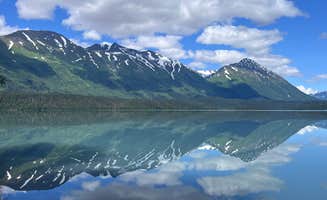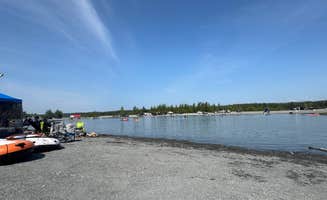Dispersed camping opportunities near Hope, Alaska extend beyond the main Chugach National Forest areas into several additional public lands. These free camping locations range from river access points to mountain trailheads, with seasonal accessibility typically limited to May through September due to Alaska's harsh winters. Snow often blocks forest roads until late spring, and early fall storms can make primitive campsites challenging for unprepared visitors.
What to do
Wildlife viewing opportunities: The Knik River area provides excellent wildlife observation chances with minimal crowds. "Great location for families. Quite," notes camper Lynn K., making it ideal for those hoping to spot moose, eagles, and occasionally bears while maintaining distance from wildlife.
Seaplane watching: At Moose Pass, visitors can observe aviation activity while enjoying primitive camping. One visitor reported, "Saw two seaplanes take off from the lake (take the Southern spot for this)." This unusual activity provides entertainment without requiring any additional fees or permits.
Hiking access: Most dispersed sites serve as jumping-off points for day hikes or backpacking trips. Mount Baldy Trailhead offers parking suitable for overnight camping with direct trail access, though no formal facilities exist. Winter access requires specialized equipment and experience with extreme cold weather camping.
What campers like
Budget-friendly base camps: Free camping near Hope provides economical options for exploring the region. According to Michael B. at Moose Pass, "We stayed for 3 days and thought it was the best so far especially for free," highlighting the value for travelers exploring the Kenai Peninsula.
Technology connectivity: Despite remote locations, many dispersed sites maintain usable cell service. Kevin H. notes, "Starlink, Visible/Verizon and Cricket/Att all good" at Moose Pass, allowing campers to maintain contact while enjoying primitive settings.
Unexpected amenities: Some free camping sites near Hope offer basic infrastructure. Ruth Arcand Park provides more than expected, with Robin H. reporting it "Has porta potty, bear safe trash, streetlight, off road enough to not be too loud," making it more comfortable than typical dispersed camping.
What you should know
Bear safety requirements: All dispersed camping near Hope requires proper food storage and waste management. Bring bear-resistant containers or plan to hang food supplies at least 10 feet high and 100 feet from your sleeping area.
Roadside noise factors: Highway proximity affects many free camping areas. Jessica K. observed at Moose Pass that "Hwy is loud but manageable, train as well," suggesting campers should select sites farther from roadways when possible.
Site cleanliness varies: Some areas suffer from previous visitor impacts. At Knik River, Mariana N. warns, "There is literally trash everywhere. Beer cans. Toilet paper. Tampons. Plus lots of people go here," indicating campers should have backup location options if first choices prove unsuitable.
Tips for camping with families
Safety considerations: When camping with children, select sites with natural boundaries. Ruth Arcand Park offers advantages as Robin H. notes, "there are often people around but they're not loud, good low-key place to be," providing a sense of security while maintaining a wilderness experience.
Entertainment options: Choose locations with natural features that entertain children. The seaplane activity at Moose Pass fascinates kids, with Michael B. noting "Floatplanes do take off multiple times a day but a neat to watch," providing built-in entertainment.
Access difficulty assessment: Decision Point Dispersed Camping requires significant preparation for families, as Skip C. cautions, "A 5 mile paddle from Whittier, AK. Watch the weather waves can build up quickly," making it suitable only for families with older children and paddling experience.
Tips from RVers
Leveling challenges: Most dispersed sites require self-leveling solutions. Michael B. found that Moose Pass offers "Nice level spots. Most with fire pit made with stones," making it more accommodating than many primitive sites for RVs requiring relatively flat ground.
Road access considerations: Many forest roads have unmarked hazards. Kevin H. describes Moose Pass as approximately "25 miles from Seward" with "Seward offers free dump and potable water - near their RV parks," highlighting the need to plan service stops before arriving at dispersed sites.
Entry/exit difficulty: Road geometry affects larger vehicles at certain sites. Michael B. warns that at Moose Pass "The entrance can be a little tricky to get in/out of due to curve in road but manageable," suggesting drivers of larger rigs should scout pullouts before committing to turns.



